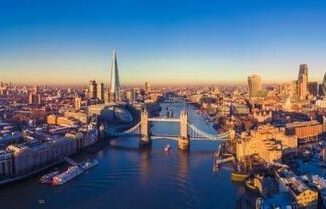
Often I have referred to the situation that the UK, Germany, California and others have set themselves up for as “hitting the green energy wall.” But now that the UK has actually gotten there and has begun to deal with the consequences, I’m not sure that “hitting the wall” is the best analogy. A better analogy might be “driving into the green energy cul-de-sac.” After all, when you hit a wall you can probably just pick yourself up and turn around and be on your way. In the cul-de-sac you are trapped with no evident way of getting out. You might be in there for a long time.
This is where the UK finds itself today. For well more than a decade, they have been aggressively and intentionally pursuing the green energy fantasy. The Net Zero emissions target was made mandatory by legislation in 2019. They have built hundreds of wind turbines and solar panels, while at the same time closing almost all of their coal mines and coal power plants. That has left them largely dependent on natural gas to back up the intermittent renewables. They have plenty of natural gas right under their feet in a large shale formation, but for years they dithered about allowing fracking to produce the gas, and then in 2019 they imposed a blanket moratorium on fracking. With production from their North Sea gas fields declining, they must buy gas on the European market. And although they don’t buy much gas directly from Russia, the European market has been driven to great heights by the cutoff of Russian supplies. Result: average annual residential energy bills in the UK, which were around £1000 as recently as earlier this year, went up to about £3000 this month, and have been projected to go as high as £5000 by this coming April absent some sort of government intervention.
And only now has it become apparent that there is no good exit strategy. That would be true even if everyone in the UK were on board with exiting from the green energy delusion, but of course that is not the case either. For years they have been prohibiting the things they have needed to do to maintain a low-cost energy system, and now they are facing years if not a decade or more to get back to where they were.
Consider some possibilities:
Perhaps the most obvious first step to get back to energy sanity would be to lift the ban on domestic fracking. Prime-Minister-for-a-month Liz Truss did just that during her brief term in office. Then new Prime Minister Rishi Sunak took office on October 25, and on October 26 — the very next day — he announced that he would reinstate the fracking ban. From Reuters, October 26:Fracking will be banned in England under Prime Minister Rishi Sunak, reversing a decision made by his predecessor Liz Truss, as the new British leader returned to a 2019 Conservative Party manifesto pledge.. . . . In parliament, Sunak was asked about fracking, and said he stood by a 2019 manifesto commitment on the issue. In the best of circumstances, it would take several years after fracking is allowed before full-scale production can be up and running to alleviate the energy crisis. But with a regulatory environment that reverses by 180 degrees every few weeks, who exactly is going to put up millions of pounds to start big fracking projects? Even if they reversed course again and opened up fracking tomorrow, it would at a minimum be multiple years before large scale new production would come on line.How about importing more natural gas from the U.S., where prices are much lower due to the fracking revolution that has enabled vastly increased production over the past decade? That is much easier said than done. There are multiple bottlenecks in the system, each of which could take multiple years to resolve. The biggest immediate bottleneck is that all U.S. facilities for cooling and compressing natural gas into LNG for export are already operating at capacity. (From Reuters, March 25, 2022: “All seven U.S. LNG export plants, however, are currently operating at capacity and liquefying about 12.7 bcfd of gas. So, no matter how high global prices rise, the U.S. cannot produce anymore LNG – at the moment.”). Other bottlenecks include shortage of LNG tankers to transport the fuel, insufficient pipeline capacity from the Permian basin gas fields to the export facilities on the Gulf coast, and insufficient LNG import capacity on the European side. The existence of all of these bottlenecks preventing U.S. exports to Europe is precisely the reason that natural gas prices are so much higher in Europe than the U.S. We’re talking years to alleviate all of these bottlenecks.What about the coal option? As recently as 2012, the UK got close to 20% of its energy (not just electricity) from coal; but by 2020, as part of the forced green energy transition, coal produced only about 2% of the UK’s electricity (and almost none of its energy for other purposes). The recent plan was to close the last coal plants by 2024, although in the current crisis the talk is that the last plants will be kept open for a little while longer. (From Reuters, May 30, 2022: “Some of the British coal-fired power plants slated for closure this year might need to stay open to ensure electricity supply this winter, the government said on Monday.” ). But there is no real possibility of going back and reopening the many plants that got closed in the last decade. In many cases they were blown up. Here is a picture of the Longannet plant in Fife, Scotland, getting blown to smithereens just last year in 2021:
Here’s the comment of the CEO of Scottish Power, Keith Anderson, quoted in the Express: “In 2016 we made the decision to close Longannet after over 40 years of generation. This step marked our commitment, and that of our parent company Iberdrola, to decarbonise the economy. This commitment has been strengthened time and again over the past five years – two years after Longannet’s closure we closed our remaining coal plants and sold our gas business, making us the first integrated energy company in the UK to generate 100% green electricity.” Such virtue Keith! The Express (February 2021) adds: “Longannet, which closed in 2016, was Scotland’s largest coal-fired power station and had been generating power since 1970. The station was capable of producing enough electricity to power two million homes each year.”
Nuclear? Given the regulatory morass and activist opposition, we’ll probably all be long dead before it can make a significant contribution.. The UK supposedly has two nuclear plants in the works, Hinckley Point C and Sizewell C. The Hinckley Point plant started construction in 2016, and is currently supposed to be finished in 2027, after lengthy delays and massive cost overruns. Sizewell C just got its green light from the UK government in July 2022, so don’t expect that one to produce any electricity before some time in the mid-2030s. According to the AP at that link, activists continue to seek to block Sizewell through litigation.Yet more wind and solar? Don’t be ridiculous. As discussed many times here, it doesn’t matter how much in the way of wind and solar facilities you build, you will still have long periods of blackout absent full backup from some dispatchable source. In the UK, all the dispatchable sources are at the minimum many years away, if not completely blocked.
Here’s one more idea: hand out hundreds of billions of pounds of subsidies to utilities to bring the costs to households down below the £5000 annually otherwise projected. This will assure that the private sector has no incentive at all to work to alleviate the crisis, and that the crisis persists essentially forever, as public debt explodes. Of course, this is the “solution” they are actually putting into place.
So they are in a cul-de-sac. And on top of everything else they can’t even muster a solid political majority for trying to get out. A substantial bloc of what they call the “Green Tories” continues to advocate for doubling down on the green fantasies. From the Evening Standard, October 29:
Green Tory MP Nadine Dorries condemns Rishi Sunak for not attending COP27 summit. . . . Ms Dorries said on Twitter it was wrong for Mr Sunak not to attend because global warming was one of the “biggest crises facing our planet”. . . . “Global warming is the biggest crisis facing our planet and net zero creates many 1,000s of jobs, which is good for the economy. COP in Glasgow was most successful ever … but don’t expect media to report that.”
For the full article click here.
<img src=”” title=”UK Trapped in The Green Energy Cul-de-Sac” />



